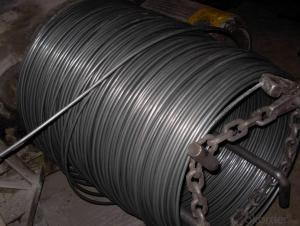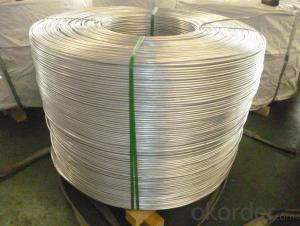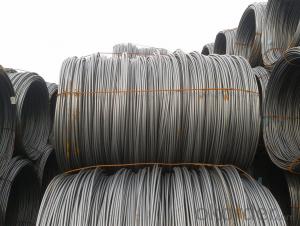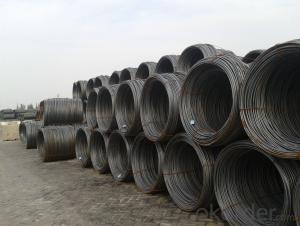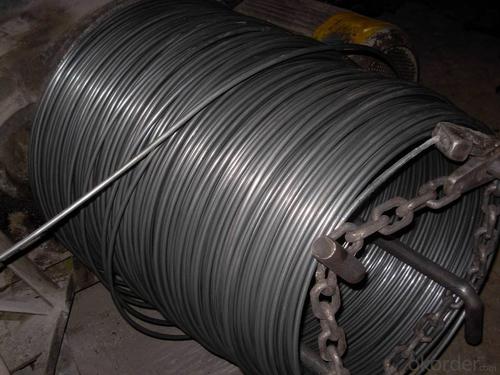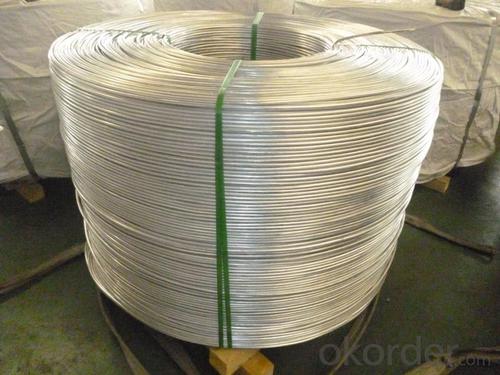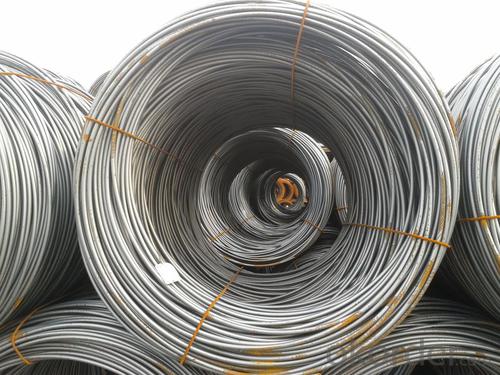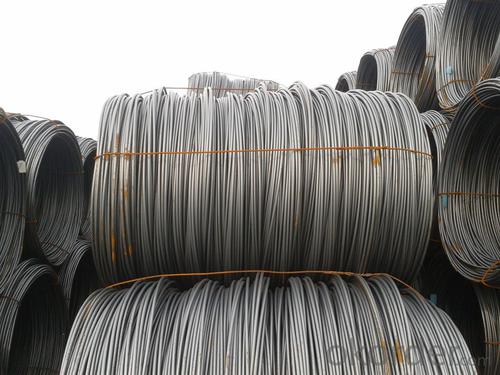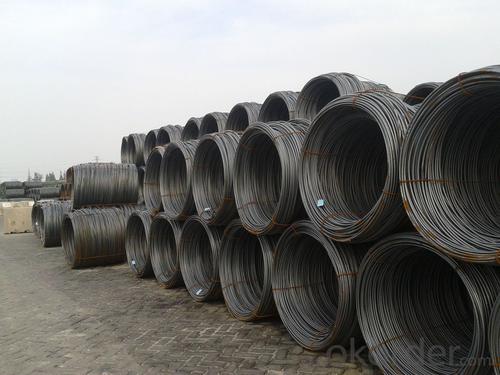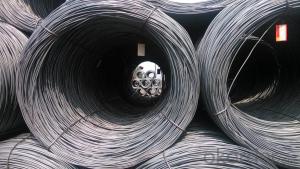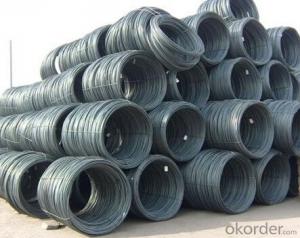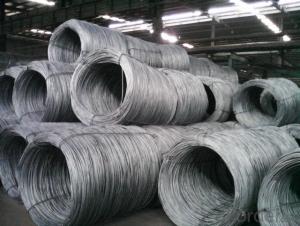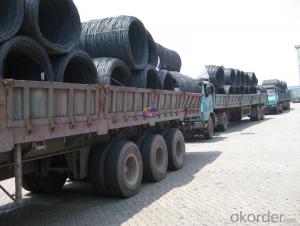SAE1006Cr Carbon Steel Wire Rod 13mm for Welding
- Loading Port:
- Shanghai
- Payment Terms:
- TT OR LC
- Min Order Qty:
- 100 m.t
- Supply Capability:
- 30000 m.t/month
OKorder Service Pledge
OKorder Financial Service
You Might Also Like
Specification
Description of SAE1006Cr Carbon Steel Wire Rod 13mm for Welding:
OKorder is offering Color Coated Steel Coil Prepainted Steel Coil at great prices with worldwide shipping. Our supplier is a world-class manufacturer of steel, with our products utilized the world over. OKorder annually supplies products to European, North American and Asian markets. We provide quotations within 24 hours of receiving an inquiry and guarantee competitive prices.
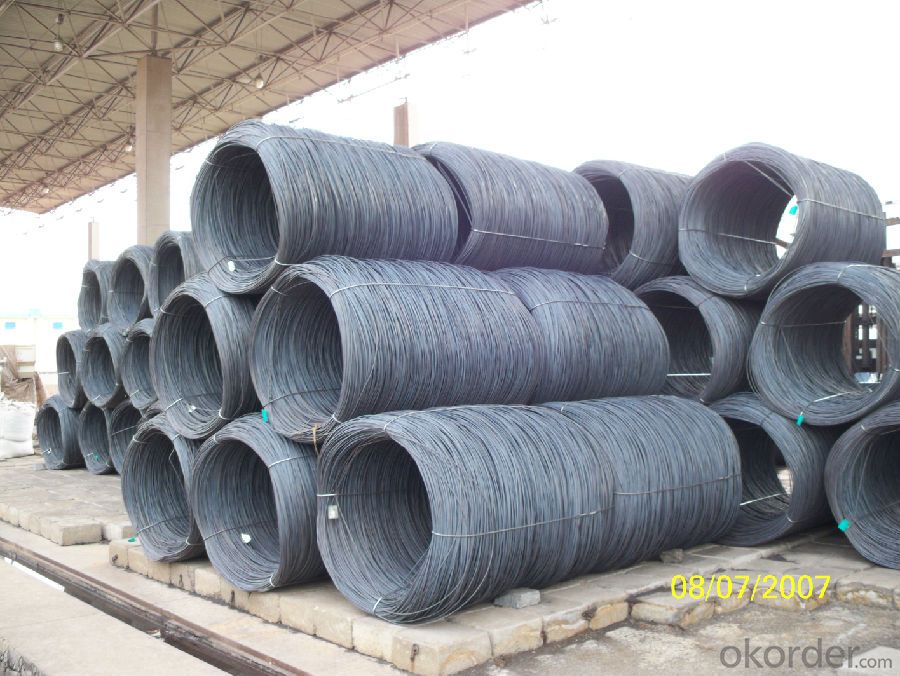
Applications of SAE1006Cr Carbon Steel Wire Rod 13mm for Welding:
Color Coated Steel Coil Prepainted Steel Coil are ideal for structural applications and are widely used in the construction of buildings and bridges, and the manufacturing, petrochemical, and transportation industries.
Main Product Features of SAE1006Cr Carbon Steel Wire Rod 13mm for Welding:
· Premium quality
· Prompt delivery & seaworthy packing (30 days after receiving deposit)
· Corrosion resistance
· Can be recycled and reused
· Mill test certification
· Professional Service
· Competitive pricing
Specifications of SAE1006Cr Carbon Steel Wire Rod 13mm for Welding:
1, Introduction: Color coated steel coils(sheets), i. E. PPGI, also called prepainted steel coils(sheets), are made of galvanized steel coils(sheets) with polymer coatings as surface. It's a new enclosure material and building board with characteristics of light-weighted, heat preserved&insulated, easily installed with bright colors.
2, Production Process: Pretreatment(Degreasing)_Drying_Chromating_Paint Basic Oil_Cooling_Drying_Color Coating_Cooling_Film-covering_Rolling Up
3, Characteristics:
Good at corrosion resistence. Besides zinc coating of the basic plate of galvanized steel sheet, the color coating as the surface has double lifetime to ensure better anticorrosion effect.
With excellent cold bending molded manufacturablity, PPGI products can be processed or directly used as final product. As being light-weighted and conveniently transported, they're widly used to replace wood to save energy.
4.There're thousands of colors can be chosen as per different application. Any color plays well in decoration.
No pollution with high recycling rate, PPGI coils and sheets are strongly recommended as enviroment-friendly products by the government.
5, eye bands and 4 circumferential bands in steel, galvanized metal fluted rings on inner and outer edges, galvanized.
| commodity | SAE1006Cr Carbon Steel Wire Rod 13mm for Welding |
| Techinical Standard: | JIS G3302-1998, EN10142/10137, ASTM A755 |
| grade | Q195,Q215,Q235,SAE1006,SAE1008 SAE1006Cr |
| Types: | Mesh welding |
| Base metal | galvanized, galvalume, cold rolled steel |
| Thickness | 0.14-1.0mm(0.16-0.8mm is the most advantage thickness) |
| Width | 610/724/820/914/1000/1200/1219/1220/1250mm |
| Type of coating: | PE, SMP, PVDF |
| Zinc coating | Z60-150g/m2 or AZ40-100g/m2 |
| Top painting: | 5 mic. Primer + 15 mc. R. M. P. |
| Back painting: | 5-7 mic. EP |
| Color: | According to RAL standard |
| ID coil | 508mm610mm |
| Coil weight: | 2--3MT |
| Package: | Properly packed for ocean freight exportation in 20'containers |
| Application: | Industrial panels, roofing and siding for painting/automobile |
| Price terms | FOB, CFR, CIF |
| Payment terms | 20%TT in advance+80% TT or irrevocable 80%L/C at sight |
| delivery time | 25 days after recepit of 20% TT |
| Remarks | Insurance is all risks |
| MTC 3.1 will be handed on with shipping documents | |
| We accept SGS certificatation test |
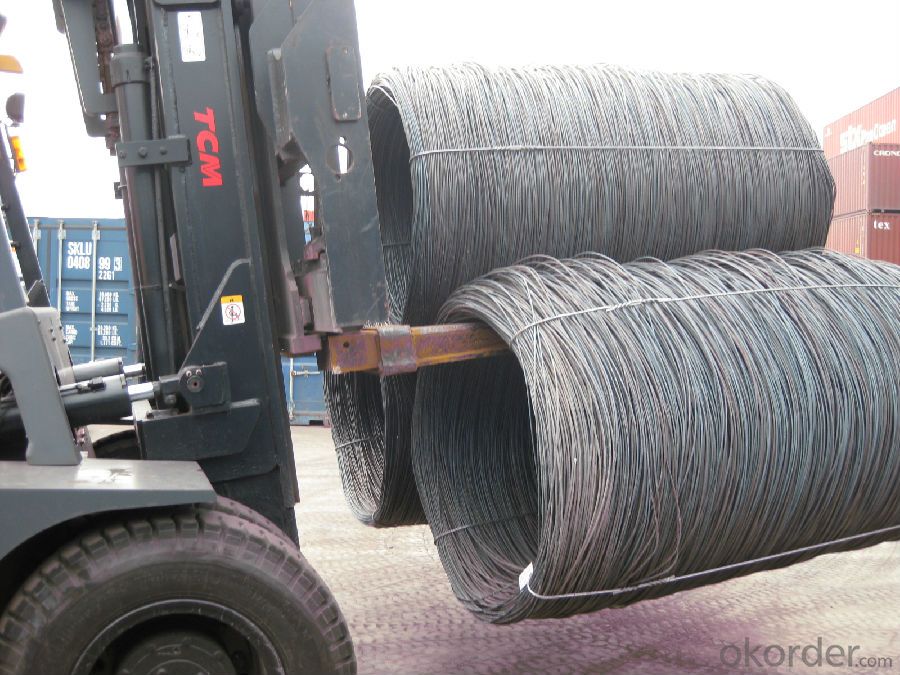
FAQ of SAE1006Cr Carbon Steel Wire Rod 13mm for Welding:
Q1: Why buy Materials & Equipment from OKorder.com?
A1: All products offered byOKorder.com are carefully selected from China's most reliable manufacturing enterprises. Through its ISO certifications, OKorder.com adheres to the highest standards and a commitment to supply chain safety and customer satisfaction.
Q2: How do we guarantee the quality of our products?
A2: We have established an advanced quality management system which conducts strict quality tests at every step, from raw materials to the final product. At the same time, we provide extensive follow-up service assurances as required.
Q3: How soon can we receive the product after purchase?
A3: Within three days of placing an order, we will begin production. The specific shipping date is dependent upon international and government factors, but is typically 7 to 10 workdays.
Q4: What makes stainless steel stainless?
A4: Stainless steel must contain at least 10.5 % chromium. It is this element that reacts with the oxygen in the air to form a complex chrome-oxide surface layer that is invisible but strong enough to prevent further oxygen from "staining" (rusting) the surface. Higher levels of chromium and the addition of other alloying elements such as nickel and molybdenum enhance this surface layer and improve the corrosion resistance of the stainless material.
Q5: Can stainless steel rust?
A5: Stainless does not "rust" as you think of regular steel rusting with a red oxide on the surface that flakes off. If you see red rust it is probably due to some iron particles that have contaminated the surface of the stainless steel and it is these iron particles that are rusting. Look at the source of the rusting and see if you can remove it from the surface.
- Q: How is steel wire rod used in the production of wire mesh reinforcement?
- Steel wire rod is used in the production of wire mesh reinforcement by being drawn through a series of dies to reduce its diameter and increase its length. This process, known as cold drawing, results in a strong and flexible wire that is then woven or welded together to create wire mesh reinforcement. The steel wire rod serves as the foundation for the wire mesh, providing strength and stability to the structure it supports.
- Q: How is steel wire rod used in the manufacturing of wire forms for musical instruments?
- Steel wire rod is an essential component in the manufacturing of wire forms for musical instruments. It serves as the base material for creating various wire shapes, such as springs, hooks, and braces, which are crucial for holding instrument parts together or providing tension. The high-quality and strength of steel wire rod ensure durability and reliability in these wire forms, enabling musicians to produce precise and harmonious sounds from their instruments.
- Q: How is steel wire rod used in the manufacturing of wire forms for recreational equipment?
- Steel wire rod is used in the manufacturing of wire forms for recreational equipment as it provides strength and durability. It is commonly used to create various wire components like hooks, springs, and frames that are essential for recreational equipment such as playground equipment, sporting goods, and camping gear. The flexibility and resilience of steel wire rod make it suitable for shaping into different forms, ensuring the safety and functionality of the equipment.
- Q: How is steel wire rod used in the production of wire for cable trays?
- Steel wire rod is used in the production of wire for cable trays as it serves as the primary raw material. The wire rod is first processed and drawn into the desired thickness and shape to form the wires that are then used to create the cable trays. These wires provide the structural integrity and support necessary for cable management and organization within the trays.
- Q: How is steel wire rod used in the manufacturing of wire for electrical heating cables?
- Steel wire rod is an essential component in the manufacturing process of wire for electrical heating cables. The wire rod serves as the primary raw material that undergoes various treatments and transformations to produce the final electrical heating cable wire. To begin with, the steel wire rod is typically made from low-carbon steel, which possesses excellent electrical conductivity and heat resistance properties. This makes it an ideal material for electrical heating cables, as it can efficiently conduct electricity and withstand the high temperatures generated by the cables. The first step in the manufacturing process involves hot rolling the steel wire rod into a thin strip, which is then cold drawn to achieve the desired wire diameter. This cold drawing process imparts high tensile strength and flexibility to the wire, ensuring it can withstand the stress and strain associated with various applications. Once the wire is formed, it is then subject to a series of heat treatments to enhance its electrical conductivity and heat resistance. This may involve annealing, where the wire is heated and slowly cooled to relieve internal stresses and improve its ductility. Additionally, the wire may be subjected to a process called galvanization, which involves coating the wire with a protective layer of zinc to enhance its corrosion resistance. After the heat treatments, the wire is further processed to achieve the required specifications for electrical heating cables. This may involve additional drawing processes to achieve the desired diameter and surface finish. The wire is then wound onto spools or coils, ready to be used in the manufacturing of electrical heating cables. In the final stage of the manufacturing process, the steel wire is incorporated into the construction of electrical heating cables. This typically involves combining the wire with other materials, such as insulation and protective sheathing, to ensure the safety and functionality of the cables. Overall, steel wire rods play a crucial role in the manufacturing of wire for electrical heating cables. Its excellent electrical conductivity, heat resistance, and strength make it an ideal material for this application. Through various treatments and processes, the steel wire rod is transformed into a high-quality wire that can efficiently conduct electricity and withstand the demanding conditions of electrical heating systems.
- Q: What are the main factors affecting the market distribution of steel wire rod?
- The main factors affecting the market distribution of steel wire rod include global demand and supply dynamics, economic growth and industrial production levels, trade policies and tariffs, technological advancements, competitive pricing, availability and cost of raw materials, transportation and logistics infrastructure, and government regulations on quality and standards. Additionally, factors such as fluctuating exchange rates, environmental concerns, and changing customer preferences also play a role in shaping the market distribution of steel wire rod.
- Q: How is steel wire rod used in the production of suspension springs for agricultural machinery?
- Steel wire rod is used in the production of suspension springs for agricultural machinery due to its high tensile strength and durability. The wire rod is first drawn and then coiled into springs of various sizes and shapes. These springs are then integrated into the suspension system of agricultural machinery, providing stability, support, and shock absorption, ensuring smooth operation and minimizing wear and tear on the equipment.
- Q: What are the main producers of steel wire rod?
- The main producers of steel wire rod are countries such as China, Japan, United States, India, and Russia.
- Q: What are the advantages of using steel wire rod in manufacturing?
- There are several advantages of using steel wire rod in manufacturing. Firstly, steel wire rod is known for its high tensile strength, making it suitable for applications that require durability and resistance to breakage. Secondly, steel wire rod can be easily manipulated into various shapes and sizes, allowing for flexibility in manufacturing processes. Additionally, steel wire rod has excellent conductivity properties, making it ideal for electrical applications. Lastly, steel wire rod is cost-effective and readily available, making it a reliable choice for manufacturers.
- Q: Can steel wire rod be used in the production of wire mesh?
- Yes, steel wire rod can be used in the production of wire mesh.
Send your message to us
SAE1006Cr Carbon Steel Wire Rod 13mm for Welding
- Loading Port:
- Shanghai
- Payment Terms:
- TT OR LC
- Min Order Qty:
- 100 m.t
- Supply Capability:
- 30000 m.t/month
OKorder Service Pledge
OKorder Financial Service
Similar products
Hot products
Hot Searches
Related keywords
